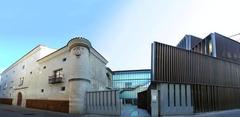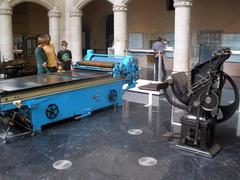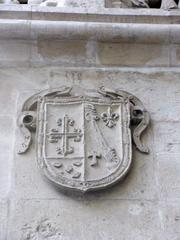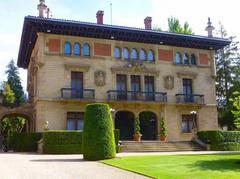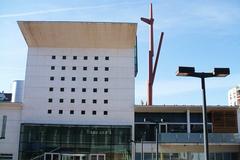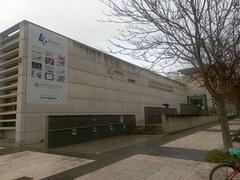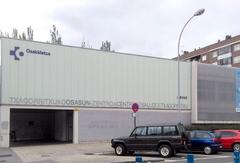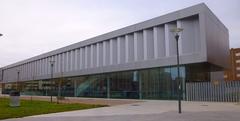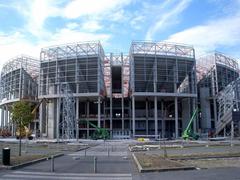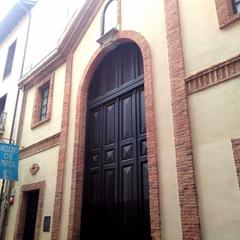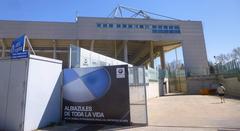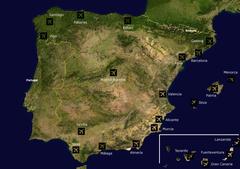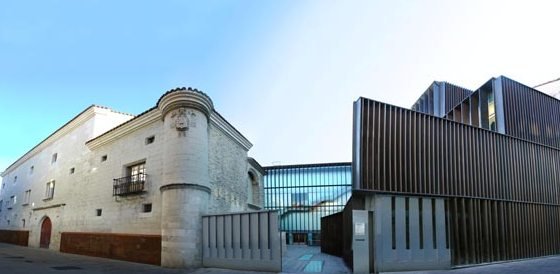
Visiting BiBat: Hours, Tickets, and Historical Insights
Updated Information on Visiting BiBat: 19/07/2024
Welcome to BiBat: An Overview
Welcome to BiBat, a fascinating cultural institution in Vitoria-Gasteiz, Spain. BiBat uniquely houses two museums under one roof: the Archaeological Museum of Álava and the Fournier Museum of Playing Cards. This dual museum offers a comprehensive cultural experience, spanning thousands of years—from prehistoric tools to medieval artifacts, and from ancient Roman relics to one of the world’s most extensive collections of playing cards. The fusion of these two museums provides an unparalleled opportunity to explore the rich historical and cultural heritage of the Basque Country. (BiBat Official Website)
Vitoria-Gasteiz, the capital of the Basque Autonomous Community, is a city steeped in history, dating back to its founding by King Sancho VI of Navarre in 1181. The city’s long and varied past is mirrored in the exhibits at BiBat, making it a must-visit destination for history enthusiasts and cultural aficionados alike. Whether you’re interested in the archaeological treasures that tell the story of human development in the region or the artistic and cultural significance of playing cards, BiBat offers something for everyone. (Vitoria-Gasteiz Tourism)
Navigate Our Comprehensive BiBat Guide
- Introduction
- History and Significance of BiBat
- Origins and Historical Context
- Archaeological Museum - A Journey Through Time
- Prehistoric Era
- Roman Influence
- Medieval Times
- Fournier Playing Card Museum - A Unique Cultural Treasure
- Historical Playing Cards
- The Fournier Legacy
- Cultural Significance
- Educational Programs
- Community Engagement
- Visitor Information
- BiBat Visiting Hours and Tickets
- Visitor Tips
- Nearby Attractions in Vitoria-Gasteiz
- FAQ
- Conclusion
Explore BiBat in Vitoria-Gasteiz: Visiting Hours, Tickets, History, and More
Introduction
Welcome to BiBat, a unique cultural institution situated in the heart of Vitoria-Gasteiz, Spain. This article will guide you through BiBat’s visiting hours, ticket prices, historical significance, and more, ensuring you have all the information needed for an enriching visit.
History and Significance of BiBat
Origins and Historical Context
BiBat combines two distinct museums: the Archaeological Museum and the Fournier Playing Card Museum. The origins of BiBat can be traced back to the rich historical and cultural heritage of the Basque Country. Vitoria-Gasteiz, the capital of the Basque Autonomous Community, has a history that dates back to the Middle Ages. The city was founded in 1181 by King Sancho VI of Navarre and has since been a significant cultural and political center.
The Archaeological Museum was established to preserve and showcase archaeological findings from the region, which include artifacts from prehistoric times to the Middle Ages. The Fournier Playing Card Museum, founded by Félix Alfaro Fournier in 1916, houses one of the most comprehensive collections of playing cards in the world. The integration of these two museums into BiBat in 2009 created a multifaceted cultural experience that highlights both the ancient history and the unique cultural artifacts of the region.
Archaeological Museum - A Journey Through Time
The Archaeological Museum at BiBat offers a chronological journey through the history of the Basque Country. The museum’s collection includes artifacts from various periods, including the Paleolithic, Neolithic, Bronze Age, Iron Age, Roman period, and the Middle Ages. Each section of the museum is meticulously curated to provide visitors with a comprehensive understanding of the region’s historical development.
Prehistoric Era
The prehistoric section of the museum features tools, pottery, and other artifacts that provide insights into the lives of the early inhabitants of the Basque Country. Notable exhibits include stone tools from the Paleolithic era and pottery from the Neolithic period. These artifacts highlight the technological advancements and cultural practices of prehistoric communities.
Roman Influence
The Roman period is represented by a collection of artifacts that illustrate the impact of Roman civilization on the region. Items such as coins, pottery, and architectural fragments provide evidence of the Roman presence in the Basque Country. The museum also features a detailed model of a Roman villa, offering a glimpse into the daily life of the Roman settlers.
Medieval Times
The medieval section of the museum showcases artifacts from the Middle Ages, including weapons, jewelry, and religious artifacts. This period was marked by significant social and political changes, and the exhibits reflect the complexities of medieval life in the Basque Country. One of the highlights is a collection of medieval manuscripts that provide valuable insights into the literary and intellectual pursuits of the time.
Fournier Playing Card Museum - A Unique Cultural Treasure
The Fournier Playing Card Museum is a testament to the rich tradition of playing card manufacturing in Vitoria-Gasteiz. The museum’s collection includes over 20,000 decks of cards from around the world, spanning several centuries. This extensive collection offers a fascinating look at the evolution of playing card design and production.
Historical Playing Cards
The museum’s collection includes some of the earliest known playing cards, dating back to the 15th century. These cards are notable for their intricate designs and craftsmanship. The collection also features cards from various cultures, including European, Asian, and American decks, each reflecting the unique artistic and cultural influences of their respective regions.
The Fournier Legacy
Félix Alfaro Fournier, the founder of the museum, was a prominent figure in the playing card industry. His company, Naipes Heraclio Fournier, became one of the leading playing card manufacturers in the world. The museum not only showcases the history of playing cards but also highlights the contributions of the Fournier family to the industry. Visitors can see original designs and printing plates used by the Fournier company, providing a behind-the-scenes look at the production process.
Cultural Significance
BiBat is more than just a museum; it is a cultural institution that plays a vital role in preserving and promoting the heritage of the Basque Country. The museum’s dual focus on archaeology and playing cards offers a unique perspective on the region’s history and culture.
Educational Programs
BiBat offers a range of educational programs and workshops designed to engage visitors of all ages. These programs include guided tours, hands-on activities, and lectures by experts in archaeology and playing card history. The museum’s educational initiatives aim to foster a deeper understanding of the region’s cultural heritage and inspire future generations to appreciate and preserve it.
Community Engagement
BiBat actively engages with the local community through various outreach programs and events. The museum collaborates with schools, cultural organizations, and community groups to promote cultural awareness and appreciation. Special events, such as temporary exhibitions and cultural festivals, provide opportunities for the community to connect with their heritage and celebrate their cultural identity.
Visitor Information
BiBat Visiting Hours and Tickets
- Opening Hours: BiBat is open from Tuesday to Saturday from 10:00 AM to 2:00 PM and from 4:00 PM to 6:30 PM. On Sundays and public holidays, the museum is open from 11:00 AM to 2:00 PM. The museum is closed on Mondays.
- Ticket Prices: General admission is €3. Entry is free for children under 12, students, and senior citizens. Special discounts are available for groups.
Visitor Tips
To make the most of your visit to BiBat, consider the following tips:
- Plan Ahead: Check the museum’s website for updated information on opening hours, ticket prices, and special exhibitions. (BiBat Official Website)
- Guided Tours: Take advantage of guided tours to gain deeper insights into the exhibits. Tours are available in multiple languages, including English, Spanish, and Basque.
- Interactive Exhibits: Engage with the interactive exhibits and hands-on activities, especially if you are visiting with children.
- Photography: Photography is allowed in most areas of the museum, but be sure to check for any restrictions.
- Accessibility: The museum is wheelchair accessible, and assistance is available for visitors with special needs.
Nearby Attractions in Vitoria-Gasteiz
While visiting BiBat, take the opportunity to explore other historical sites in Vitoria-Gasteiz:
- Cathedral of Santa María: A stunning example of Gothic architecture.
- Plaza de la Virgen Blanca: A picturesque square in the heart of the city.
- Artium Museum: A contemporary art museum showcasing Basque and Spanish artists.
- Green Belt: A network of parks and green spaces perfect for a leisurely stroll.
FAQ
- What are the BiBat opening hours? BiBat is open from Tuesday to Saturday from 10:00 AM to 2:00 PM and 4:00 PM to 6:30 PM. On Sundays and public holidays, it is open from 11:00 AM to 2:00 PM. The museum is closed on Mondays.
- How much are BiBat tickets? General admission is €3. Entry is free for children under 12, students, and senior citizens. Special discounts are available for groups.
Conclusion
BiBat in Vitoria-Gasteiz offers an enriching experience that combines the rich history of the Basque Country with the unique cultural artifact of playing cards. With its extensive collections, educational programs, and community engagement, BiBat is a must-visit destination for anyone interested in history and culture. Plan your visit today and immerse yourself in the fascinating world of BiBat.
Stay Up to Date
For more information, download the Audiala mobile app, check out other related posts, or follow us on social media for the latest updates.
Sources and Further Reading
- BiBat Official Website, 2024, BiBat
- Vitoria-Gasteiz Tourism, 2024, Vitoria-Gasteiz
- Fournier Museum, 2024, Fournier Museum
